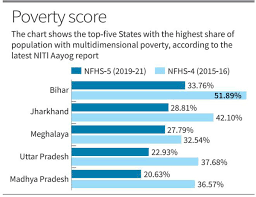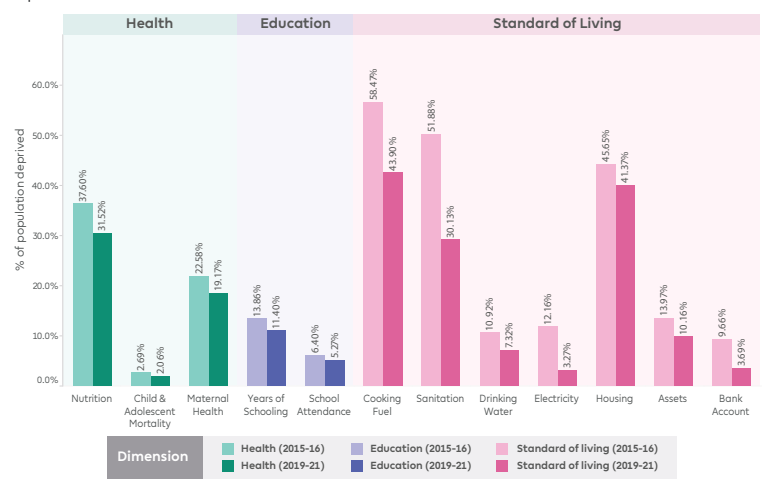Social Justice
National Multidimensional Poverty Index
- 19 Jul 2023
- 4 min read
For Prelims: National Multidimensional Poverty Index, NITI Aayog, National Family Health Survey, Poverty, Sustainable Development Goals.
For Mains: National Multidimensional Poverty Index.
Why in News?
Recently, NITI Aayog has released the Report “National Multidimensional Poverty Index: A Progress Review 2023”, claiming that a significant number of people have come out of multidimensional poverty in India.
What is the National Multidimensional Poverty Index?
- The report has been prepared based on the latest National Family Health Survey-5 ( 2019-21 ) and is the 2nd edition of the National Multidimensional Poverty Index (MPI).
- The first edition of MPI was released in 2021.
- The MPI seeks to measure Poverty across its multiple dimensions and in effect complements existing poverty statistics based on per capita consumption expenditure.
- It has three equally weighted dimensions – Health, Education, and Standard of living.
- These three dimensions are represented by 12 indicators such as nutrition, child and adolescent mortality, maternal health, years of schooling, school attendance, cooking fuel, sanitation, drinking water, electricity, housing, assets, and bank accounts.
What are the Key Highlights of the Report?
- Reduction in Multidimensional Poverty:
- Between 2015-16 and 2019-21, India witnessed a significant decline in the number of multidimensionally poor individuals.
- Around 13.5 crore people moved out of multidimensional poverty during this period.
- Decline in Poverty Percentage:
- India's population living in multidimensional poverty decreased from 24.85% in 2015-16 to 14.96% in 2019-21, reflecting a decline of 9.89 % points.
- Rural-Urban Divide:
- The rural areas of India experienced the fastest decline in poverty, with the poverty rate dropping from 32.59% to 19.28% between 2015-16 and 2019-21.
- In urban areas, the poverty rate reduced from 8.65% to 5.27% during the same period.
- State-Level Progress:
- In terms of number of MPI poor, Uttar Pradesh saw the largest decline in the number of poor individuals, with 3.43 crore (34.3 million) people escaping multidimensional poverty.
- The states of Bihar, Madhya Pradesh, Odisha, and Rajasthan also witnessed significant progress in reducing multidimensional poverty.
- Bihar saw the fastest reduction in MPI value in absolute terms with the proportion of multidimensional poor reducing from 51.89% to 33.76% in 2019-21 followed by Madhya Pradesh and Uttar Pradesh.
- SDG Target:
- The MPI value for India has nearly halved from 0.117 to 0.066 between 2015-16 and 2019-21.
- The intensity of poverty has reduced from 47% to 44%, indicating that India is on track to achieve SDG (Sustainable Development Goals) Target 1.2 (reducing multidimensional poverty by at least half) ahead of the stipulated timeline of 2030.
- Improvement in Indicators:
- All 12 indicators used to measure multidimensional poverty showed marked improvements.
- The impact of Swachh Bharat Mission (SBM) and Jal Jeevan Mission (JJM) is evident in the swift 21.8% points improvement in sanitation deprivations.
- The Poshan Abhiyan and Anaemia Mukt Bharat have contributed to reduced deprivations in health.
- The provision of subsidized cooking fuel through the Pradhan Mantri Ujjwala Yojana (PMUY) has positively transformed lives, with a 14.6% improvement in cooking fuel deprivations.
What are the Government Initiatives for Reducing deprivations and Improving the Well-Being of Citizens?
- National Rural Livelihood Mission (NRLM)
- The Mahatma Gandhi National Rural Employment Guarantee Act 2005 (MNREGA)
- Pradhan Mantri Awaas Yojana-Gramin (PMAY-G)
- Public Distribution System (PDS)
- Pradhan Mantri Awas Yojana (PMAY)
- Pradhan Mantri Sahaj Bijli Har Ghar Yojana (Saubhagya)
- Pradhan Mantri Ujjwala Yojana (PMUY)









